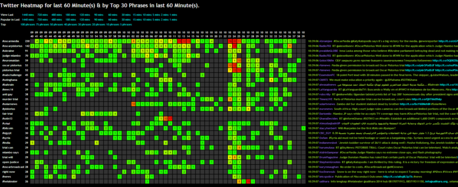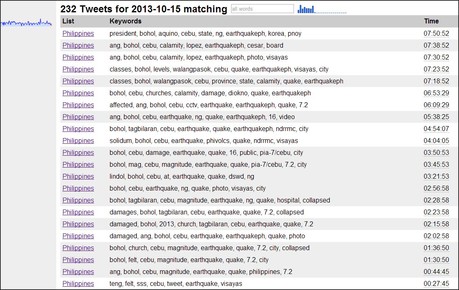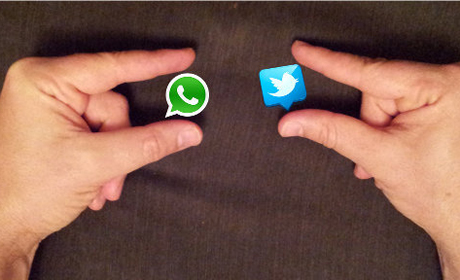
Social media is a vital tool for distributing news and information, but the increasing number of platforms and messaging apps, which interlink billions of people across the world, also bring new opportunities for newsgathering.
Here are four examples of how journalists and news outlets are using social platforms to source stories and gather information in different ways.
Monitoring social media
Facebook interest lists and Twitter apps like Tweetdeck are already widely used for their ability to collect relevant sources on a topic in list form, helping journalists to stay updated on their specific beat, but there are ways to delve deeper into social networks to find stories.
Social newswire Storyful have developed specialised tools for monitoring "hundreds" of lists on Facebook, Twitter, YouTube and other networks for keywords which may relate to a news event, news editor Malachy Browne told Journalism.co.uk.
"Temblor is the Spanish for earthquake," he said as an example of how journalists can search for news in other languages to find international stories.
Words such as "kidnap, bomb, shooting, explosion" add more "weight", he explained, indicating that "there is an additional importance of something happening in a location".
Storyful's own Heatmap software monitors all the sources the newswire has set up – between 35 and 40,000 according to Browne – for potential news based on the "velocity" of words or tweets.
On the day Angela Merkel fractured her pelvis while skiing, Heatmap "lit up" for the keyword 'Merkel', he said, "originating in Germany and then spreading further afield".

Screenshot of Storyful's Heatmap software from the morning of February 25 2014. Image courtesy of Storyful.
Another programme, Alertbot, is more geographically specific, monitoring the various lists set up around countries, cities, states or other criteria and judging "the intensity of the conversation on a per-location basis" said Browne.
With hundreds of lists, tens of thousands of sources, and new social media accounts established everyday, it is important to ensure Storyful's sources are still relevant, said Browne.
A third piece of software, Recommender, analyses the network of lists, highlights "nodes of influence" and makes suggestions of other people that could be added.

Screenshot of Storyful's Alertbot software on the Philippines list from October 15 2014. Image courtesy of Storyful
"The whole basis for this is to draw news from the noise of social media," Browne said, "and if you've got a really tight list of gatekeepers for a particular country – or even roving reporters that are trustworthy and reputable – then you've got good quality information coming from a particular location."
As an example of how the software is put into practice, he highlighted the attack on the Westgate mall in Nairobi in September last year, where armed men stormed the shopping centre, throwing grenades, shooting shoppers and taking hostages.
"Heatmap lit up with the word attack, Westgate and Nairobi," Browne explained. "It was a Saturday morning around 10 and most news organisations are light staffed on a Saturday morning.
"The tech picked it up and we went straight to our Kenya list. We've got reputable sources – a number of whom happened to be at the mall and reporting on it from there – so we were able to get good information that was trustworthy and put a tweet out about it from there."
Storyful clients were directed to the Kenya list of sources, while Storyful reporters continued to search for content and sources around the story, including video and photographs.Mobile phones are the first pieces of technology to newsworthy events around the worldMalachy Browne, Storyful
Other than Storyful, which was recently bought by News Corp for $25 million (£15 million), platforms like Mention and NewsWhip offer the ability to monitor social media, a source which Browne will only become more important as the prevalence of mobile technology continues to grow.
"Millions of people are joining various different social media platforms and mobile phones are the first pieces of technology to newsworthy events around the world," said Browne. "Very often they're the first cameras there as well so very quickly people start talking about what they're seeing if it's something dramatic. The next step is to take the keywords that people are using to describe the event and use that local knowledge to go and find images and bring that story to visual for our news clients."
Utilising social networks
Although social media can be vital in getting the first word on breaking news stories it can also be a source for more investigative journalism.
Eliot Higgins, who goes by the pseudonym Brown Moses for his blog on munitions used in the Syrian civil war, has built a career and formidable list of sources and contacts from social media since he started his blog two years ago.
Much of his work revolves around finding, verifying and analysing YouTube videos from Syria to tell stories of the evolving conflict.
"It really started with an event called the Houla massacre [in May 2012]," Higgins told Journalism.co.uk. "A village was attacked by [reportedly] pro-government forces and a large number of people were killed. Until then I had been looking at videos and thinking about how they were uploaded, then I started thinking there must be other accounts."
He started to collect YouTube channels into a spreadsheet, organised by region, to monitor each day but also sought out related Facebook groups and Twitter accounts to directly contact the individuals on the ground who were uploading the videos.
"Videos don't just appear as a singular thing," Higgins said. "There may be a related Facebook post or a Tweet or you could Skype the person who did it and find more information.
"After the 21 August [chemical weapons] attacks I had some people in Damascus contact me and say they'd read my work and invite me to speak with one of the doctors who treated some of the patients."
A video by KafarSousah Revolt on YouTube, verified and included in a blog post by Brown Moses on the August 21 attacks, purporting to show animals killed by chemical weapons
Higgins' work on the 21 August attacks in Damascus is ongoing – news organisations and official observers are still not 100 per cent sure who the perpetrators were or where the chemical weapons came from – but his contact with groups on social media means he can access sources and information otherwise difficult to reach.
A completed story in which his work played a key role appeared in the New York Times last February, claiming the Saudi government was arming Syrian rebels with weapons from Croatia.
"I was checking videos every single day and started to notice that there were new weapons appearing in certain areas," he said. "The first thing was look at all the videos on the channels where these weapons were appearing and add it all to a big spreadsheet as I was gathering the information.
"Then I looked at the videos from the same region and looked at the list from all the different regions to see if there were other groups using these weapons."
In a painstaking process of analysing videos and cross-referencing channels he deduced the new weapons were left over from the conflict in Yugoslavia two decades earlier, being brought in from southern Syria and spreading out across the country from there. He passed the information to the New York Times who consulted their sources and were able to "develop the story further".There are whole networks of information that you can explore and discover worthwhile stories fromEliot Higgins, Brown Moses
Higgins is now considered an expert on Syria and on the wider subject of digging deep into social media networks to find stories, itself the topic of a website he hopes to launch in the coming months, sharing his techniques and ideas.
"I don't think its unique [to Syria]," he said. "I've been approached by people who want to do it in other conflicts. In Nigeria, for example, they're using the same techniques to gather information because time and time again you see arms groups using YouTube, Facebook and Twitter to get their message out."
Beyond arms groups, video is an important resource for other news stories. YouTube has become an important platform for recent events in Ukraine, with Mashable reporting that more than 90,000 videos relating to the crisis have been uploaded since 1 February, an 82 per cent increase on the number of uploads in the previous two months.
"As mobile technology becomes more widespread and phones become more advanced and spread further into other countries this will play an important role," said Higgins. "Syria has produced a massive amount of video footage, millions of Facebook and Twitter posts. Not all of it is useful, but it's about being able to sort through that and turn it into useful information, like the Croatian weapons story and my work on 21 August.
"There's a lot of information there that is very relevant to news stories, not just 'here's the latest picture of a bomb going off' or 'here's the latest atrocity'. There are whole networks of information that you can explore and discover worthwhile stories from."
Closed social networks

By Tsahi Levent-Levi on Flickr. Some rights reserved
At the BBC, user-generated content (UGC) and social media hub assistant editor Trushar Barot has been researching the usefulness of closed social networks in finding sources for news.
"This all really started off the back of the London riots in 2011 when our team was slightly taken on the back foot when we realised that a lot of intelligence of what was going on on the ground, the pictures and videos, were being shared on BlackBerry messenger rather than Twitter, Facebook and YouTube, which were the normal go to sites for a lot of this content," Barot told Journalism.co.uk.
BlackBerry messenger was a "closed ecosystem", he said, in that unless a user had an account and was directly connected to individuals sharing the information "there is no way to tap into it".
Since then, Barot has been monitoring chat apps like WhatsApp and WeChat in the Asia Pacific area, as well as Line, KakaoTalk and Kick that, are becoming increasingly prevalent around the world.Having a WhatsApp account and giving people the opportunity to communicate in that app actually opened up access to people they wouldn't have reached in any other wayTrushar Barot, BBC
WhatsApp processes around 50 billion messages from its 450 million users each day, a figure that led to Facebook acquiring the messaging platform for $19 billion in February, while recent figures from WeChat revealed the app has more than 350 million monthly active users.
Such numbers represent enormous potential for journalists and news organisations in reaching sources for stories, Barot said.
"One of our programs on BBC World Service used [WhatsApp] quite effectively during Typhoon Haiyan at the back end of last year," he said. "Because so many people in that region in the Philippines were already on WhatsApp as a natural place where they would share information and their content, just for having an account within WhatsApp and giving people the opportunity to communicate with that program inside that app actually opened up access to people that they wouldn't have reached in any other way."
In this case, the production team on the ground in the Philippines set up an account on the team phone and prompted listeners to contact the program via WhatsApp alongside the more traditional channels.
"The people in the Philippines who have WhatsApp still have very small data subscriptions," he said, "but because it's free or very low cost it became a much simpler and easier way for them to actually send out their content to us than if they were trying to email us, which was often difficult, because they had to be at a computer. Or by sending it through text message which would cost them a lot more."
In some poorer parts of the world mobile is leapfrogging desktop as the first choice technology for online communication, so being able to access those networks, even if they are closed, is important for journalists to be able to reach all the relevant sources for news.
Geolocating social media
As more apps and mobile software include GPS locations in the metadata of images or video, the ability to quickly find information relevant to a story, or verify multimedia after the event, becomes easier for journalists. Facebook's Graph Search is a quick option for finding sources in registered to particular locations, but more detailed geolocation software is emerging for finding content or individuals.
Browne said a lot of Instagram content is geolocated – "a lot more than than Facebook, YouTube or other platforms" – which can give journalists a head start on verification as you can "check out the co-ordinates and see if there are topographical reference points".
Storyful searched for GPS tags around the Westgate mall as the crisis was unfolding and found a number of different sources.
"We found images being posted from one of the upper floors of victims on the ground outside in the car park," Browne said, "of emergency services when they arrived, treating those people; of someone being lead out with their arms over their head by a member of security; other people hiding on a rooftop.
"So we were really getting a sense of what was happening there and this happened to be the wife of a Kuwaiti diplomat [posting the photos]. You could see from this person's social media profile that they looked like they were Kuwaiti living in Nairobi, describing all this in Arabic.Is it going to become easier to potentially do a quick geolocation search around a big news event?Trushar barot, BBC
"You wouldn't really think to search social media for search terms in Arabic on an event in Nairobi but because we had the geolocation and the tools to pick that up we were able to get these images."
Higgins is particularly interested in InformaCam, an app launched in December which includes important metadata in images and video by default, as it will make the verification process of using UGC simpler.
"What's useful about this is it records the angle the camera is facing and the GPS data," he said, "stuff that is incredibly useful when you're trying to verify videos. That is encrypted so it can be difficult to fake and it can be sent securely so if they [the users] get arrested by security services they can protect themselves."
Looking further ahead, Barot said wearable technology could revolutionise the amount of images and video being shared online as people "become mobile broadcasting units or mobile newsrooms depending on the situation they're in the middle of", capturing pictures from smartwatches or transmitting video through headsets like Google Glass.
Managing and filtering all this content is the issue though, he said, and although those questions will have to be answered more fully as the technology evolves, geolocation could become vital in finding sources around breaking news.
"Is it going to become easier to potentially do a quick geolocation search around a big news event in a certain part of the world and immediately identify the 15 or 20 people that are wearing wearable tech of some description in that exact location," he said.
"You can ping them a message directly and get them on air almost immediately, giving a vivid eye witness account, where its appropriate, or get them to stream live what's going on. Or share their pictures and videos and intelligence directly to our teams on the ground. The more you think about it the more unlimited that potential becomes."
Browne, Higgins and Barot were all interviewed as part of a podcast on the future of newsgathering.
Correction: NewsCorp bought Storyful for $25 million, not £15 million, as originally stated
Free daily newsletter
If you like our news and feature articles, you can sign up to receive our free daily (Mon-Fri) email newsletter (mobile friendly).
Related articles
- 10 creative ways to interview celebrities and experts
- How Reuters, Newsquest and BBC experiment with generative AI
- Standing out in a crowded market: what makes a top news podcast?
- Fact-based journalism is under attack. What can we do about it?
- 15 online communities for journalists you should know about









